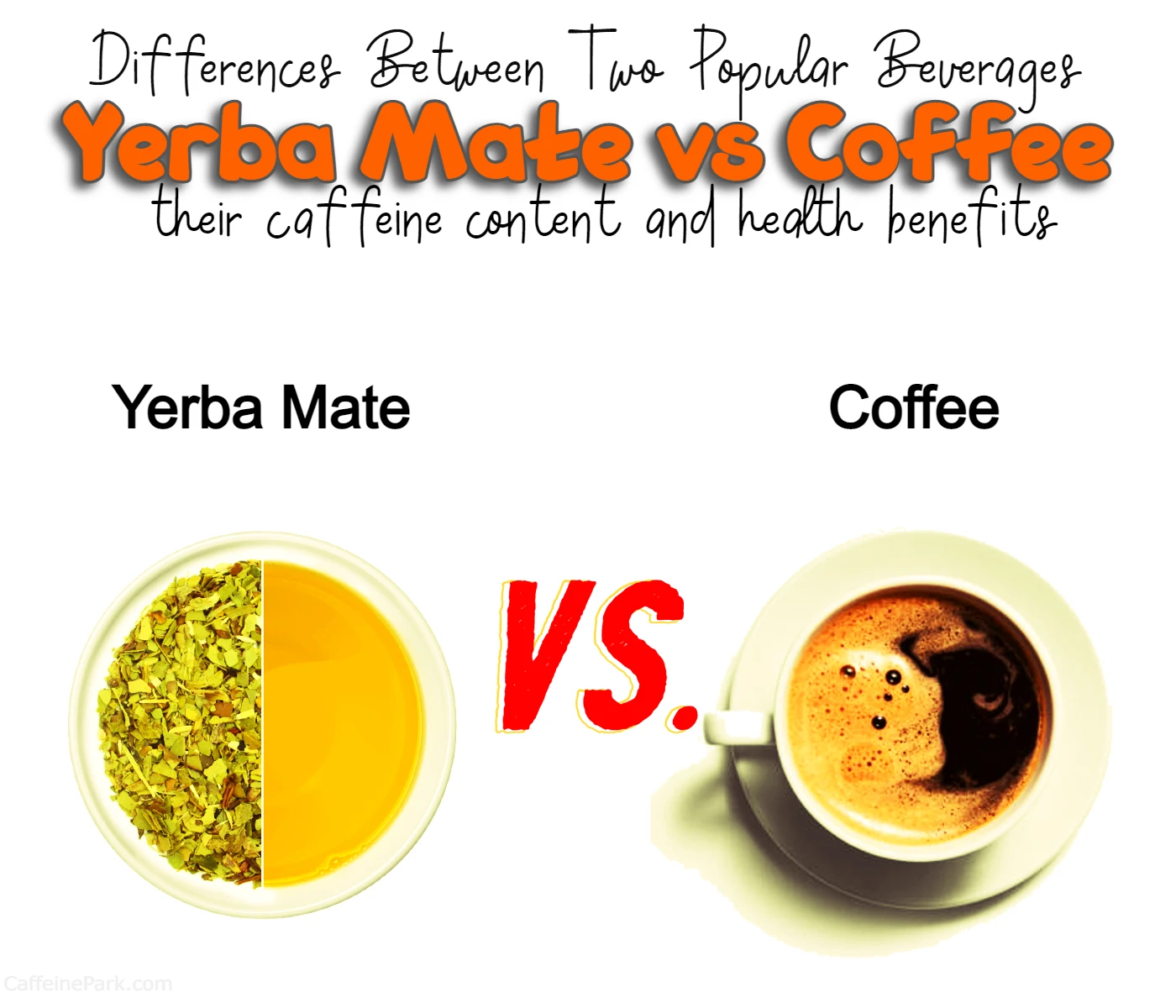
Welcome to my blog post about the differences between coffee and yerba mate! If you’re someone who loves a good cup of caffeine but wants to explore different options, this post is for you. Coffee and yerba mate are two popular beverages that have distinct differences in taste, origin, and cultural significance. By the end of this post, you’ll have a better understanding of these differences and be able to decide which beverage is right for you.
So, grab a cup of coffee or yerba mate, and let’s dive in! In this post, we’ll be exploring the origin and history of coffee and yerba mate, the taste and flavor of each beverage, the caffeine content, and the health benefits. We’ll also take a look at the cultural significance of both beverages and how they are enjoyed around the world.
Whether you’re a die-hard coffee fan or a lover of yerba mate, or maybe you’re just looking to switch things up, this post has something for everyone. So, grab a comfortable seat and get ready to learn more about coffee and yerba mate. Don’t forget to read until the end of the post to see my final thoughts and recommendations!
Here’s a quick chart highlighting some of the main differences between yerba mate and coffee:
| Yerba Mate | Coffee |
|---|---|
| Made from the leaves of the yerba mate plant | Made from roasted coffee beans |
| Unique taste described as earthy and grassy | Rich, bold flavor and aroma |
| Contains caffeine and other compounds for energy and focus | Higher caffeine content per cup |
| Antioxidant and anti-inflammatory properties | Reduced risk of Parkinson’s disease and improved cognitive function |
| Traditional beverages in South America often shared in social settings | Consumed by millions of people around the world, often as a morning ritual |
Keep in mind that this chart only scratches the surface of the differences between these two beverages. To learn more, read the full post above!
Difference between Coffee and Yerba Mate
Origin and History
Coffee
Coffee has a long and rich history that dates back to the 9th century in Ethiopia, where it is said to have been discovered by a goat herder named Kaldi. From there, the popularity of coffee spread throughout the Middle East and eventually Europe, where it became a beloved beverage in the 17th century. Today, coffee is one of the most widely consumed beverages in the world, with millions of people enjoying a cup of coffee every day.
Yerba Mate
Yerba mate, on the other hand, is a traditional South American beverage that has been consumed for centuries by the indigenous people of Argentina, Brazil, Paraguay, and Uruguay. It is made by steeping the leaves and stems of the yerba mate plant in hot water, and then sipping it through a metal straw called a bombilla. Yerba mate has a rich cultural significance in South America and is often enjoyed in social settings with friends and family.
Taste and Flavor
Coffee
Coffee is known for its rich, bold flavor and aroma. The taste of coffee can vary depending on the type of beans used, the roasting process, and the brewing method. Some people prefer a light roast with a mild, fruity flavor, while others enjoy a dark roast with a smoky, robust flavor. Coffee is often consumed with milk or cream and sugar to balance out the bitterness of the coffee.
Yerba Mate
Yerba mate has a unique taste and flavor that is often described as earthy and grassy. It has a slightly bitter taste and a subtle sweetness that is reminiscent of green tea. Yerba mate is often enjoyed without any additives, but some people choose to sweeten it with honey or sugar.
Caffeine Content
Coffee
Coffee is known for its high caffeine content, which is one of the reasons why it is so popular. The amount of caffeine in a cup of coffee can vary depending on the type of beans used, the brewing method, and the serving size. On average, a cup of coffee contains between 95mg of caffeine.
Yerba Mate
Yerba mate also contains caffeine, but in a smaller amount than coffee. The amount of caffeine in a cup of yerba mate can vary depending on the strength of the brew, but on average, a cup of yerba mate contains about 40mg of caffeine.
Health Benefits
Coffee
Coffee has been studied extensively for its health benefits, and it has been found to have several positive effects on the body. Some of the health benefits of coffee include:
- Reduced risk of Parkinson’s disease
- Lower risk of type 2 diabetes
- Reduced risk of liver cancer and cirrhosis
- Improved cognitive function
- Reduced risk of depression and suicide
Yerba Mate
Yerba mate is also known for its health benefits, and it has been consumed for centuries for its medicinal properties. Some of the health benefits of yerba mate include:
- Increased energy and focus
- Improved digestion
- Boosted immune system
- Reduced risk of cardiovascular disease
- Antioxidant and anti-inflammatory properties
Cultural Significance
Coffee
Coffee has a rich cultural significance in many countries around the world. In Italy, for example, coffee is a central part of daily life and is often enjoyed at cafes or bars with friends or colleagues. In Turkey, coffee is brewed in a special pot and served in small cups, with a tradition of fortune-telling based on the leftover coffee grounds. In Ethiopia, coffee has a spiritual significance and is often served in elaborate ceremonies.
Coffee also plays a significant role in many aspects of culture, from literature to music. In the United States, for example, coffee shops have become popular gathering places for writers and artists, and coffee is often referenced in popular music. In Brazil, coffee is an important part of the economy and has shaped the country’s history and culture.
Yerba mate
Yerba mate, on the other hand, has a deep cultural significance in South America, particularly in Argentina, Uruguay, and Paraguay. Yerba mate is often consumed in social settings, such as at mate circles or gatherings with friends and family. It is also an important part of cultural traditions and ceremonies in many indigenous communities in South America.
Final thoughts
I hope this article has provided you with a better understanding of the differences between coffee and yerba mate. While both beverages have their unique characteristics, they offer distinct benefits and cultural significance. Whether you prefer the bold flavor of coffee or the earthy taste of yerba mate, both are great options for a pick-me-up or a social beverage with friends and family.
Remember, it’s always important to consume caffeine in moderation and to pay attention to how your body reacts to it. If you’re looking for a caffeine-free alternative, there are plenty of options available, such as herbal teas or fruit-infused water.
If you have any further questions or comments about coffee or yerba mate, feel free to leave them in the comments section below. And don’t forget to share this article with anyone who may be interested in learning more about these popular beverages. Thanks for reading!
Alternative to Coffee and Yerba Mate
If you’re looking for an alternative to coffee or yerba mate, there are many options to choose from. Here are a few popular alternatives:
- Herbal tea: Herbal teas are a great alternative to coffee or yerba mate, as they are naturally caffeine-free and come in a wide variety of flavors. Some popular herbal teas include chamomile, peppermint, and ginger.
- Matcha: Matcha is a type of green tea that is finely ground into a powder. It contains caffeine, but also has a high concentration of antioxidants and amino acids, which provide a calming effect.
- Kombucha: Kombucha is a fermented tea that has become increasingly popular in recent years. It contains a small amount of caffeine, but also has probiotics and other health benefits.
- Golden milk: Golden milk is a turmeric-based drink that is often made with milk and spices like cinnamon and ginger. It is caffeine-free and has anti-inflammatory properties.
- Hot chocolate: If you’re in the mood for something sweet, hot chocolate is a delicious alternative to coffee or yerba mate. It contains a small amount of caffeine, but also has antioxidants and can boost your mood.
Remember, there are many alternatives to coffee and yerba mate, so don’t be afraid to try something new!
FAQs
Yerba mate has a unique taste that is often described as earthy and grassy, while coffee has a rich, bold flavor and aroma.
Coffee has a higher amount of caffeine per cup compared to yerba mate. However, yerba mate contains other compounds that provide energy and focus.
Coffee has been shown to have a reduced risk of Parkinson’s disease and improved cognitive function, while yerba mate has antioxidant and anti-inflammatory properties.
Yerba mate is often prepared by steeping the leaves in hot water and drinking it from a gourd with a metal straw. Coffee is typically brewed by steeping roasted coffee beans in hot water using a coffee maker or French press.
Yerba mate is a traditional beverage that is consumed in South American countries like Argentina, Uruguay, and Paraguay, and is often shared in social settings. Coffee has a rich cultural history and is consumed by millions of people around the world, often as a morning ritual.
Read More:





